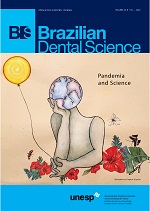Diagnostics of non-carious lesions of dental hard tissues with the methods of optical spectroscopy and radiography
DOI:
https://doi.org/10.14295/bds.2020.v23i2.1866Abstract
Objective: This work aims to use new spectroscopic and radiographic methods to study the dental hard tissue erosion and abfraction, as these lesions are actually quite difficult to be diagnosed in clinical practice. Material and Methods: This in vivo study was conducted on 60 patients with early erosion and 60 patients with abfraction at the cervical area by means of laser-induced fluorescence (LIF) and multilayer spiral computed tomography (MSCT). Results: In comparative dental hard tissues studies LIF spectra from intact and affected areas, it was noted multidirectional fluorescence intensity dependence between areas affected by abfraction and intact areas. MSCT technique allowed assessing the degree of damaged areas, especially at deeper stages. Conclusion: Although LIF and MSCT methods presented limitations, it was shown their effectiveness in the diagnosis of abfraction and erosion by detecting changes in the morphological structure as well as in the chemical and mineral composition of affected dental hard tissues. So LIF and MSCT methods can be successfully used in order to develop new medical devices which will provide most accurate clinical diagnose of different stages of dental erosion and abfraction.
KEYWORDS
Fluorescence spectroscopy; Spiral computed tomography; Tooth demineralization; Tooth erosion.
Downloads
Downloads
Additional Files
Published
How to Cite
Issue
Section
License
Brazilian Dental Science uses the Creative Commons (CC-BY 4.0) license, thus preserving the integrity of articles in an open access environment. The journal allows the author to retain publishing rights without restrictions.
=================




























